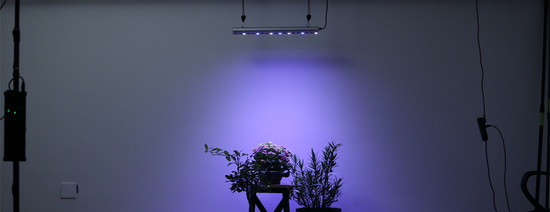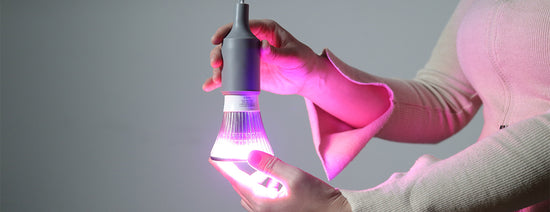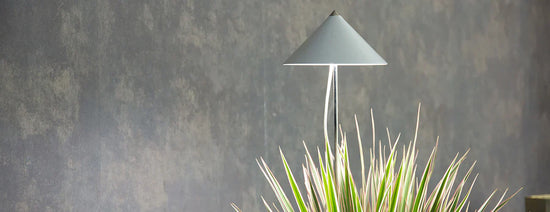Overwintering of plants with the help of plant lamps
As soon as the temperatures drop below 5 °C, it is time to bring your favorite plants indoors or to winter storage for the winter. There are also important care instructions for your plants during the winter to get them through the cold season. With a suitable LED plant light, your plants will remain healthy and strong throughout the winter.
The types of plants that require more care include, above all, evergreen, exotic plants and some succulents. These should not be too dark even in winter. The reason is that plants need sunlight for photosynthesis. During photosynthesis, light energy is converted into chemical energy, so that compounds and nutrients are formed and can be stored, from which the plant feeds. The photosynthesis performance is usually reduced in winter. One speaks of the so-called vegetation dormancy. However, enough photosynthesis should still be able to take place so that the plants do not "starve". During this dormant phase there is little or no growth in the plants, but the preservation of the leaves and the root/fine root system can be significantly improved by additional lighting.
Plant dormancy sets in depending on the original habitat and growth conditions in the actual area of origin. Most of our indoor plants today come from the tropical or subtropical climate zone and therefore need additional plant lighting in winter, since the reduced light spectrum in winter or in dark rooms is not sufficient for you. This also applies to exotic garden plants that should overwinter in a greenhouse (preferably heated) or indoors.
Blue and white wavelengths of plant light are essential for overwintering plants during dormancy. The wavelengths in the blue light spectrum (430-450nm) are used to maintain or grow the leaves. Together with a white full spectrum (400-700nm), which stimulates the maintenance and promotion of the root system, the most important light factors for the winter are present.
Tip:
Light is just one of many issues during the winter. When wintering, also pay attention to the following factors:
-Temperature
- Substrate (loose substrate for air exchange)
- Nutrient availability (sodium, phosphorus, potassium, magnesium in the form of fertilizer)
- Water availability and humidity (especially with dry heating air)
By darkening and storing in cool rooms you support the dormancy of your plants. With an LED lamp you give your plant a soft light, so that the dormant vegetation is additionally supported. The plant species enter different dormant phases in winter or not. Depending on the plant species, they then adapt by shutting down their metabolism. Temperatures around 5°C to 10°C are ideal. The cooler the temperature during the winter, the darker the room can be kept. If the temperatures are too high, the plants react by "losing up" and forming water shoots with thin, small leaves. It also helps to prune the plants before storage, so they have fewer shoots and leaves to tend to and can maintain them more easily. You can remove old and dead shoots in particular without hesitation. In the best case, however, you should wait until the beginning of spring before pruning, when the plant will boost its metabolism again and be better able to care for and overflow the wounds that have arisen.
Make sure to ventilate the wintering room from time to time. This is useful on milder spring days to ensure proper humidity. Brown leaf edges and tips as well as pest epidemics are usually an indication of insufficient humidity. Indoor fountains or bowls filled with water also contribute to an increase in humidity.
It is sufficient to water your plants only moderately (approx. once a week) when the vegetation is dormant. Make sure that the temperature of the water was able to adapt to the room temperature.
What to do in case of pest infestation?
If you notice a pest infestation on your plants during the winter, please place the infested plants individually first and use biological pesticides for the time being. The focus should be on the underside of the leaves and on the branches, as this is where pests prefer to be. For hard-leaved plants, you can use oil-based insecticides (soft-leaved plants do not tolerate oil-based insecticides). Plant protection sticks have little or no effect, since the plant cannot absorb or convert much from the substrate during dormancy. Consistent collection of fallen plant parts helps with fungal infestation.
LED plant lamps for plant preservation in winter
Even in corners or in rooms without sufficiently bright light, you don't have to do without real plants if you offer the plants a suitable light spectrum with LED lamps. The light used should consist of the spectrum of the white and red wavelength range. A plant lamp with white light has a full spectrum of 400-700 nm , which primarily stimulates the development of the root system. In addition, the broad spectrum of light stimulates the growth of new leaves, the leaves that are already there are strengthened and are more intensely colored because the chlorophyll production and photosynthetic capacity of the plants are increased. If the full spectrum is then supplemented by the light spectrum of the red wavelengths (640-660 nm ), flower formation is promoted and the flowering period is extended.
How much water does a plant need in winter quarters?
The colder a winter quarters are, the more precisely the soil moisture must be set. Because wet and at the same time cold root balls lead to damage faster than dry and warm substrates. Therefore, especially in winter, watering should never be done in advance, but always in small quantities, since even small water supplies are sufficient for a few days. The soil should dry completely before the next watering, which can sometimes take three to four weeks in colder winter quarters. If loamy substrates are used, which can store the water very well and for a long time, caution is required. For example, some citrus plants are cultivated in such soils. Since their roots are particularly sensitive to waterlogging, our advice here is: It's better to water a little too little than a little too much! However, the bales should not dry out completely!





